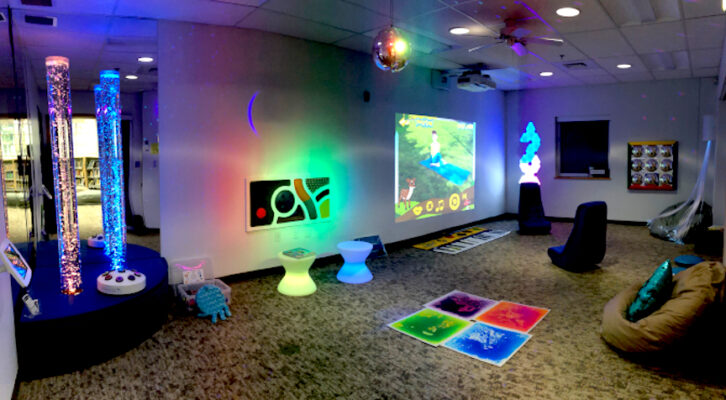
How Can Literary Spaces Support Neurodivergent Readers and Writers?
Jess deCourcy Hinds on Creating Inclusive Places for Everyone
For thirteen years, I directed a high school library in Queens, New York. The former factory loft was airy and light-filled, but not wheelchair accessible, so I pursued some renovation grants. When my students heard the news, they immediately asked me, “Will you make it neurodivergent-friendly too?”
“Of course,” I said, vowing to make a transformation happen. But before I even started googling “neurodiversity + libraries” I looked around—and noticed that something had changed since we’d emerged from the isolation of COVID. We all interacted with the library space differently.
More than ever, teens and faculty migrated to the study carrels, preferring to write in cubicles instead of at long communal tables out in the open. Students sequestered themselves in a spruced up walk in closet I euphemistically called the “tutoring room.” Kids burrowed into smallest of library crevices, popping in earbuds and crunching up small.
This wasn’t surprising; we’d all worked from our little bedrooms for so long, and maybe some of us felt reluctant to rejoin the world. Relearning how to use a library, and how to read deeply, has been a long process for everyone, but students on the spectrum would need extra support during this reacclimation. And libraries, bookstores, writing classes and other spaces that nurture readers need to consider neurological experiences when making accessibility plans.
Since the pandemic, I encountered more people in the literary community openly identifying as neurodivergent, traumatized or struggling with attention issues. Many authors I interacted with in my author series mentioned plans to be evaluated for ADHD. Others who already identified as neurodivergent seemed bolder and prouder about their identities than I remembered pre-COVID. Perhaps our society is becoming more open. Many of us already knew our brains were wired differently, but now, after surviving a worldwide catastrophe, we were no longer afraid to talk about it.
For example, on the first day of ninth grade, one student marched up to the library circulation desk. “Do you have NeuroTribes?” she asked, referring to Steve Silberman’s book. “I’m neurodivergent! And that’s a great book. I want to read it again.”
“Again?” I asked, smiling. The book is 560 pages.
“I used my hyperfocus to finish in a week,” she explained, using a term to describe the sustained focus of a neurodiverse person who is especially passionate about something.
I attended a training at NYU’s ASD Nest program led by an autistic former librarian who said that libraries were often neurodivergent students’ favorite places because they invited deep exploration on a certain topic. I’d noticed this as well; indeed, many of my neurodivergent students were natural researchers and library assistants.
The interior of the cove provides a quiet, stimulation-free zone for students to use noise-cancellation headphones and borrow iPads to access audiobooks.
Over the years, I’ve often displayed books by neurodivergent writers, inspired by Milkweed’s Multiverse series, which features books in all genres by neurodivergent authors. Showcasing these authors was only one part of my library transformation, however. I was determined to change the physical space.
All winter, I combed through library furnishing websites before I discovered rounded, halfmoon bookcases called “reading coves.” The elegant, sinuous shelves could be arranged in various snaking formations, back-to-back, or zigzags. The shelving units had built-in seating and seemed to create a ring of safety wrapping around the readers.
I showed the photos to students in the Abled-Disabled Alliance, an affinity group of disabled students and their allies. The teenagers were enthusiastic. One student asked to dim the harsh fluorescent lightning and provide fidget toys like squeeze balls and plastic poppers. Noise-muffling headphones were also suggested.
Another suggestion: a “crash pad” for a student experiencing dysregulation. I’d seen a student run into the library and spin around before clattering down into her chair; maybe a cushion would give her a softer landing. Rocking and swaying chairs can also help a student needing vestibular stimulation.
Through the spring of 2021, I continued exploring library accessibility through a course I taught called “Disability and Equity in the Library.” More than half of the students in the course identified as disabled or neurodivergent, and I appreciated their candor about their lives. They also seemed to like the class. “In most classes, we just talk about ideas,” one student remarked. “In this class, we’re actually going to make something. And it’s cool that you’re asking me to design my own school library. No one asked me to do that before.”
I framed my course as a journey I was taking with the students since I didn’t feel like any kind of expert in disability inclusion. Soon I learned that what my students and I were doing could be described as “participatory design.”
According to Scott W.H. Young and Celina Brownotter of Montana State University in their 2018 article, “Toward a More Just Library: Participatory Design with Native American students,” this practice enables people to create spaces collaboratively with the people who will use them.
As Scott and Brownotter write, the tenets of participatory design include “shared power,” “equal expertise,” “mutual learning,” “co-creation and determination,” and “democracy.”
If you want people to relax and think innovative, bold ideas, why not ditch those hard-backed chairs and get down on the floor?
Many times, disabled and neurodiverse people find it empowering to shape the spaces they will use, and their input is invaluable to architects and designers. This concept was also explored beautifully in What Can a Body Do? by Sara Hendren (named Best Book of the Year by NPR and LitHub).
Together, the students and I photographed the library, sketched new floor plans, and imagined Multisensory Environments (also known as MSE) with light and sound effects to help people self-soothe. We read perused many online photos of library sensory rooms—many of which appear very expensive and in Australia. Some include light projection similar to a baby’s celestial nursery accessory. Other MSEs feature 6 foot-tall lava lamps known as “bubble tubes.”
During one of my first airplane trips since COVID, I stumbled upon what appeared to be an MSE in the LaGuardia Airport in New York. In the middle of overpriced shops with New York-themed merchandise, a neon fountain glimmered like a mirage. The area boasted sculptural climbing structures and designer rocking chairs. I took my toddler there to calm down from a tantrum. But I needed it too.
After experiencing that MSE at LaGuardia, I could imagine a similar space in a library. Spending five minutes by a fountain or waterfall could make a writer’s mind feel more supple, creative and open.
But how was this neurodiverse redesign going to come together? Seeking guidance about my next steps, I decided to reach out to an expert, Renee Grassi. A neurodiverse-idenitfying librarian and consultant on sensory support and programming in libraries, Grassi has been based in Minnesota, but was recently appointed Library Director at the Lake Bluff Public Library in Illinois. I’d read articles about her “Sensory Storytime” in the library for Autistic children and was impressed. I could see why she was a leader in the field of neurodiversity inclusion in libraries.
In the next few years, I expect to see a surge of awareness around neurodiversity in learning spaces within higher education.
When I shared our library’s progress with Grassi—and bemoaned my lack of space and budget—she was encouraging of my efforts. She also urged me to scale down and simplify. So maybe I couldn’t install a fountain in the library, but the reading coves were a good start.
“Hand-held items can achieve the same goal as those big bubble makers,” she noted. Grassi suggested purchasing “calming support kits” to lend out to patrons the way you sign out books. These soothing kits might include squeeze balls or other fidget toys.
The librarian also recommended back jack chairs as a cost- and space-effective solution to rocking chairs. Wiggle pads are other seating options Grassi recommended in literary spaces. If you want people to relax and think innovative, bold ideas, why not ditch those hard-backed chairs and get down on the floor?
Not long after I spoke with Grassi, I learned that my alma mater, Smith College, was launching a neurodiverse classroom space. I reached out to the college for more details, hoping for insights into how I could make my own author series and creative writing classes more accommodating. Smith Provost and Dean of the Faculty, Michael Thurston, responded via email. He explained that the neurodiverse classroom would be housed a 6,200 square foot space in the library.
“Most existing large classrooms assume a lecturer and seating in inflexible theater-style arrangements,” he wrote. “The Young [Library] classroom, by contrast, will provide multiple styles of moveable furnishings and state-of-the-art technology that can respond to differences in thinking and sensory experience to enhance student learning. Specific features will include group tables, quiet breakout rooms equipped with technology, and rolling chairs for students who need more movement.”
Smith might be a leader in designing a neurodiverse classroom, but I am certain that it will not be alone. In the next few years, I expect to see a surge of awareness around neurodiversity in learning spaces within higher education more generally and also programs for writers such as MFA programs and writing conferences such as the Association of Writers & Writing Programs (AWP). There is a section under AWP’s Accessibility page about quiet hallway space and wellness rooms with low fluorescent lighting. Sometimes, the simplest adjustments go a long way.
“Even without tremendous resources or time, it’s possible to accomplish a lot,” Grassi assured me. “Inclusion is about the spirit, not the space.” Still, I continued fantasizing about a cascading digital waterfall—and my Disability & Equity class devoted an inordinate amount of time to studying wooden and fabric samples for our reading coves. I didn’t want to be materialistic, but I did feel concerned with the physical world we were building. Should we choose pine wood veneer or oak? Red or blue cushions?
Everyone but one student in the class voted for blue, describing it as a calm color. One autistic student in the class expressed the opposite viewpoint: “Red is peaceful. It’s blue that makes me panic and want to run out the door!” This comment helped me remember how subjective color, and all sensory experiences, can be.
At long last, I placed an order for two reading coves with a pine veneer and navy cushions. The interior of the cove provides a quiet, stimulation-free zone for students to use noise-cancellation headphones and borrow iPads to access audiobooks. There was so much more that I wanted to do. Although I left the library a few months ago, I am in touch with the new librarian, and we often brainstorm about future renovation ideas. I co-authored an academic article with Nava Bahrampour, a student leader from the Abled-Disabled Alliance for Urban Library Journal on a year of work, which, in all honesty, seems like a tiny step forward.
Still, I sensed a new vibe in the library as soon as the reading coves were installed. My library was no longer just a space filled with towering bookcases, or “stacks.” When I sat down on the cushion inside the cove, I felt the bookcase hugging me, holding me, anchoring me. I opened my book to the first page and dove in.
Jess deCourcy Hinds
Jess deCourcy Hinds is a writer and librarian in NYC. Her work has been featured in numerous outlets, from NPR to the New York Times' Modern Love column to literary journals such as Quarterly West. She works as a youth librarian at two Title 1 schools, and teaches graduate-level courses on children's literature. Photo credit: Doug Weiner.



















